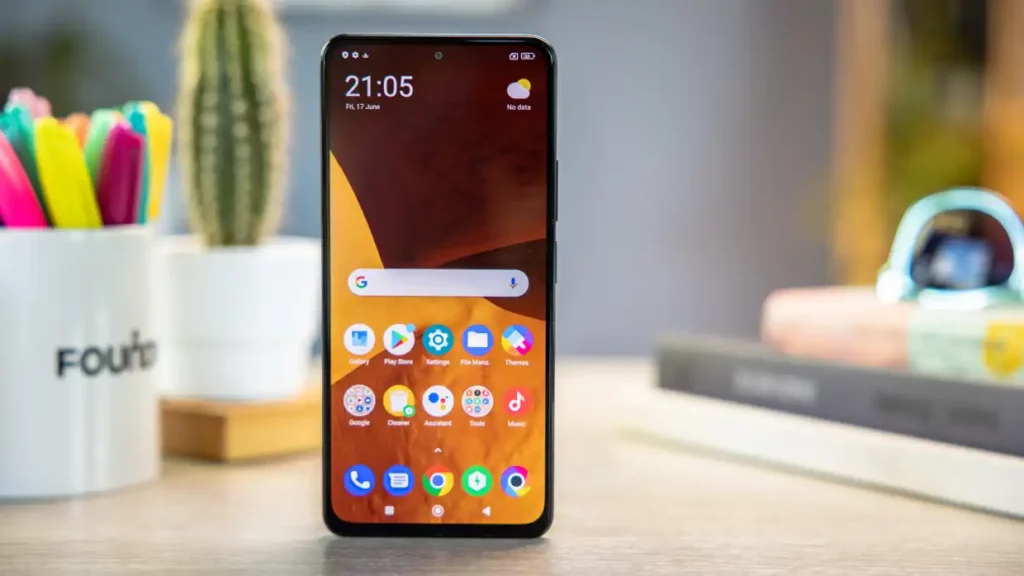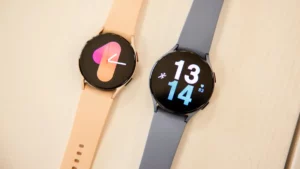In this article you will learn about Poco F4 review in depth.
Expert’s Rating
Pros
- Dazzling display
- 67W fast charging
- Great performance for the price
Cons
- F3 offers better bang for buck
- Battery life not as long as rivals
- Generic design
Price When Reviewed
Pricing starts at 32,999 (6GB + 128GB) and the model we looked at costs the same.
It was in the spring of this year that Poco introduced the F4 GT, a gaming phone with cutting-edge hardware and a striking aesthetic. The new Poco F4 is a more subdued phone, but it’s cheaper and better for anyone who wants an all-around, good-value handset.
I’ve put the Poco F4 through its paces to test its durability, reliability, and performance in daily use.
Design & Build
- Sleek but generic design
- IP53 rating
- No headphone jack
Black, silver, and green Poco F4s are on sale now. The GT’s design may have been too flashy for certain people, and while this Poco isn’t as flashy as some older models, it’s still nearly too simple to stick out. Poco phones, including the F4, suffer from a lack of a consistent design language.
It’s comparatively thin at 7.7mm and light at 195g. Although it’s quite lightweight, the IP53 classification ensures protection from dust and mild precipitation. The F4 can compete with phones like the Realme 9 Pro+ because to its affordable price and basic waterproofing features.
A headphone jack is absent from the Poco F4, just as it is from the Poco F4 GT model (but likely not many in this age of Bluetooth headphones). The fingerprint reader on the power button is located on the right side of the device and, in my testing, performed reliably.
The Poco F4’s vapour chamber cooling mechanism works in tandem with the phone’s seven-layer heat dissipation construction to keep the chip at an optimal temperature even while under heavy load. However, the phone itself still gets very hot when you’re gaming.
Screen & Speakers
- 120Hz refresh rate
- Stereo speakers
- Variable refresh rate
The Poco F4’s 6.67-inch Full High Definition Plus Super AMOLED display with 120 Hz refresh rate and Dolby Vision compatibility is one of the phone’s top features. In comparison to the F3, Xiaomi claims that this phone’s newer panel enhances colour reproduction, clarity, and HDR performance.
Videos and pictures appear fantastic on this screen; however, I can’t compare the F4 to the F3. The brightness is good enough that I can use it outside without suffering from excessive glare. Neither was constant maximum brightness a requirement.
Depending on the activity you’re engaging in, the phone’s display may toggle between 60Hz and 120Hz refresh rates. This allows for fluid scrolling in social media feeds, but reduces the refresh rate at other times to preserve battery life. You can also choose to permanently bind it to either option.
Dolby Atmos is supported by the F4’s dual speakers. Both ends of the call sound loud and clear, and music has depth and clarity despite lacking bass.
Specs & Performance
- Up to 8GB RAM + 256GB storage
- Qualcomm Snapdragon 870 processor
- Decent daily performance
The Snapdragon 870 processor powers the Poco F4. Although it’s not the newest processor out, it nevertheless provides a fluid performance and is extremely adept of multitasking without a problem. Although Genshin Impact, a difficult game, does become a little sluggish when visuals are set to medium, it can still run some titles like it on lesser settings.
Performance is therefore satisfactory, but there is a drawback: if you already own the Poco F3, there is no justification for upgrading.
You may read our interview with Poco’s global head, who attributes this choice to Qualcomm’s failure to offer a new, reasonably priced chip that would have been a good replacement for the Snapdragon 870.
Cameras
- 64Mp main camera with OIS
- Mixed night mode
- Video up to 4K at 60fps
The Poco F4’s camera suite consists of a 64MP main shooter with optical image stabilisation, an 8MP wide-angle shooter, and a 2MP macro shooter.
During the day, you can take photos with clear details and interesting textures. This phone’s HDR mode is strong, like that of other mid-range devices, making colours pop but feeling a little unnatural. On sunny days, the camera may also experience flare.
The most notable improvement over the Poco F3 is the inclusion of OIS. Low-light photography does not compromise on image quality or colour saturation. However, the F4 does struggle at night when there are bright lights in the frame. In comparison to other mid-range smartphones, the end result isn’t quite as impressive.
However, the OIS’s stabilisation and motion blur reduction on moving subjects is spotty at best.
Portrait mode allows for an adequate amount of background blur, but at the expense of sharpness and detail, especially in low light. Pictures taken with the 8MP wide-angle lens aren’t as sharp or vibrant as those taken with the main camera. Still, it comes in handy for taking pictures of landscapes or large groups.
The macro camera is unimpressive, as it is on most low- to mid-priced smartphones. Indeed, it’s a 3Mp reduction compared to the F3’s 5Mp macro camera.
4K video at 60 frames per second is possible. The internal mics do a great job of picking up sound, and the video is sharp and colourful. Stabilization can be used to compensate for shaky hands or walking motion, though it is currently only supported in 1080p at 30 frames per second.
A punch-hole 20MP selfie camera is located in the upper middle of the display, which is a mixed bag in and of itself. While portrait mode’s colour reproduction is fine, finer textures like strands of hair can get lost in the haze of the background. It shouldn’t come as much of a surprise that the vast majority of smartphones with software that applies this blurring effect has the same problems.
Battery Life & Charging
- 67W fast charging
- Just over a day’s battery life
- No wireless charging
The Poco F4 shares the F3’s lacklustre battery life. With the maximum refresh rate, numerous games, and mobile 5G enabled, the F4’s 4500mAh battery struggled to last through an entire day of use.
The 8 hours and 26 minutes the phone managed in our benchmarks is reflective of this; this time is significantly lower than that of the F4 GT and F3. However, if you use the phone sparingly and make good use of its variable refresh rate and battery saver modes, it will last much longer.
The battery can be recharged to 85% in 30 minutes thanks to the 67W fast-charging technology. It’s not the fastest charging we’ve seen, but it’s plenty quick enough that even a five-minute charge will still do enough to give you a few more hours of use out of the phone.
oftware
- App bloat on MIUI 13
- Based on Android 12
MIUI 13, Xioami’s skin atop Android 12, powers the Poco F4. Poco has not announced when or for how many years its devices will receive Android updates. There is evidence that it took the F3 about five months after release to receive the most recent operating system update.
When it comes to software, Xiaomi has never been the most trustworthy, and the Poco F4 is no exception with its plethora of unnecessary pre-installed apps. Worst of all is the Poco store app, a virtual shop selling nothing but Poco phones (not helpful if you just bought the F4) and one Poco wearable device.
The settings menu is accessed by swiping down from the top right corner, while the notifications tray is accessed by swiping down from the top left corner. In my opinion, it is more convenient to have both components of Android preinstalled at once.
It’s not all bad news, though; the OS makes excellent use of the screen’s dazzling resolution by providing options like “Vivid,” “Saturated,” and “Original” for the panel’s colour mode. The display’s hues can be adjusted to match the surrounding lighting or customised using the colour wheel.
If you’re used to using Google’s products, you may be surprised by the layout differences between this phone and one running stock Android because MIUI is not the cleanest skin of Android out there.
Price & Availability
The base model Poco F4, which has 6GB of RAM and 128GB of storage, costs £379/€399/32,999, while the top-end model, which has 8GB of RAM and 256GB of storage, costs £429/€449. The most expensive version in India has 256GB of storage and 12GB of RAM and costs 39,999.
During the review period, you could get a free Poco Watch when you purchased it from the Poco store. The recommended price of a Poco had been cut in half by Amazon, saving you twenty pounds. As of this writing, a monthly payment plan for the Poco F4 was not available.
Although the Poco F4 and other Poco phones aren’t officially sold in the United States, readers in the States can import them from China using online marketplaces like AliExpress.
The Poco phone has a lot of features for its low price. The screen is fantastic for video playback, and the performance is on par with that of more expensive mid-range handsets.
The F4 is £50/€50 more expensive than the F3, which provides very similar experience for a cheaper price, so it’s not easy to justify the extra cost just for the addition of optical image stabilisation (OIS) and fast charging. We also like the Google Pixel 6a and the OnePlus North 2T, both of which can be had for about the same price.
Compare it to the competition by checking out our roundup of the top midrange phones and top Xiaomi phones.
Specs
- Android 12 with MIUI 13
- 6.67in Full HD+ (1080×2400) 20:9 AMOLED, 120Hz
- Corning Gorilla Glass 5 display
- Qualcomm Snapdragon 870 processor
- 6/8/12GB RAM
- 128/256GB internal storage
- 64Mp, f/1.79, main camera with OIS
- 8Mp, f/2.2 ultrawide
- 2Mp, f/2.4 macro
- 20Mp, f/2.45 selfie camera
- Video up to 4K @60fps
- Fingerprint scanner (in power button)
- Wi-Fi 6
- Bluetooth 5.2
- GPS
- NFC
- 5G
- Dual Nano SIM
- USB-C
- IP53
- Stereo speakers
- 4500mAh non-removable battery
- Fast charging 67W
- 163.2 x 75.95 x 7.7 mm
- 195g



